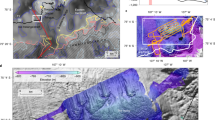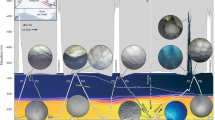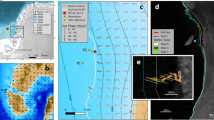Abstract
Thinning ice in West Antarctica, resulting from acceleration in the flow of outlet glaciers, is at present contributing about 10% of the observed rise in global sea level1. Pine Island Glacier in particular has shown nearly continuous acceleration2,3 and thinning4,5, throughout the short observational record. The floating ice shelf that forms where the glacier reaches the coast has been thinning rapidly6, driven by changes in ocean heat transport beneath it. As a result, the line that separates grounded and floating ice has retreated inland7. These events have been postulated as the cause for the inland thinning and acceleration8,9. Here we report evidence gathered by an autonomous underwater vehicle operating beneath the ice shelf that Pine Island Glacier was recently grounded on a transverse ridge in the sea floor. Warm sea water now flows through a widening gap above the submarine ridge, rapidly melting the thick ice of the newly formed upstream half of the ice shelf. The present evolution of Pine Island Glacier is thus part of a longer-term trend that has moved the downstream limit of grounded ice inland by 30 km, into water that is 300 m deeper than over the ridge crest. The pace and ultimate extent of such potentially unstable retreat10 are central to the debate over the possibility of widespread ice-sheet collapse triggered by climate change11,12.
This is a preview of subscription content, access via your institution
Access options
Subscribe to this journal
Receive 12 print issues and online access
$259.00 per year
only $21.58 per issue
Buy this article
- Purchase on Springer Link
- Instant access to full article PDF
Prices may be subject to local taxes which are calculated during checkout




Similar content being viewed by others
References
Rignot, E. et al. Recent Antarctic ice mass loss from radar interferometry and regional climate modelling. Nature Geosci. 1, 106–110 (2008).
Joughin, I., Rignot, E., Rosanova, C. E., Lucchitta, B. K. & Bohlander, J. Timing of recent accelerations of Pine Island Glacier, Antarctica. Geophys. Res. Lett. 30, 1706 (2003).
Rignot, E. Changes in West Antarctic ice stream dynamics observed with ALOS PALSAR data. Geophys. Res. Lett. 35, L12505 (2008).
Shepherd, A., Wingham, D. J., Mansley, J. A. D. & Corr, H. F. J. Inland thinning of Pine Island Glacier, West Antarctica. Science 291, 862–864 (2001).
Wingham, D. J., Wallis, D. W. & Shepherd, A. Spatial and temporal evolution of Pine Island Glacier thinning, 1995–2006. Geophys. Res. Lett. 36, L17501 (2009).
Shepherd, A., Wingham, D. & Rignot, E. Warm ocean is eroding West Antarctic ice sheet. Geophys. Res. Lett. 31, L23402 (2004).
Rignot, E. J. Fast recession of a West Antarctic glacier. Science 281, 549–551 (1998).
Thomas, R. H., Rignot, E., Kanagaratnam, P., Krabill, W. & Casassa, G. Force-perturbation analysis of Pine Island Glacier, Antarctica, suggests cause for recent acceleration. Ann. Glaciol. 39, 133–138 (2004).
Payne, A. J., Vieli, A., Shepherd, A. P., Wingham, D. J. & Rignot, E. Recent dramatic thinning of largest West Antarctic ice stream triggered by oceans. Geophys. Res. Lett. 31, L23401 (2004).
Schoof, C. Ice sheet grounding line dynamics: Steady states, stability, and hysteresis. J. Geophys. Res. 112, F03S28 (2007).
Mercer, J. H. West Antarctic ice sheet and CO2 greenhouse effect: A threat of disaster. Nature 271, 321–325 (1978).
Oppenheimer, M. Global warming and the stability of the West Antarctic ice sheet. Nature 393, 325–332 (1998).
Nitsche, F. O., Jacobs, S. S., Larter, R. D. & Gohl, K. Bathymetry of the Amundsen Sea continental shelf: implications for geology, oceanography, and glaciology. Geochem. Geophys. Geosyst. 8, Q10009 (2007).
Walker, D. P. et al. Oceanic heat transport onto the Amundsen Sea shelf through a submarine glacial trough. Geophys. Res. Lett. 34, L02602 (2007).
Jacobs, S. S., Hellmer, H. H. & Jenkins, A. Antarctic ice sheet melting in the southeast Pacific. Geophys. Res. Lett. 23, 957–960 (1996).
Hellmer, H. H., Jacobs, S. S. & Jenkins, A. Oceanic erosion of a floating Antarctic glacier in the Amundsen Sea. Antarct. Res. Ser. 75, 83–99 (1998).
Jenkins, A. The impact of melting ice on ocean waters. J. Phys. Oceanogr. 29, 2370–2381 (1999).
Jenkins, A., Vaughan, D. G., Jacobs, S. S., Hellmer, H. H. & Keys, J. R. Glaciological and oceanographic evidence of high melt rates beneath Pine Island Glacier, West Antarctica. J. Glaciol. 43, 114–121 (1997).
Dupont, T. K. & Alley, R. Assessment of the importance of ice-shelf buttressing to ice-sheet flow. Geophys. Res. Lett. 32, L04503 (2005).
Goldberg, D., Holland, D. M. & Schoof, C. Grounding line movement and ice shelf buttressing in marine ice sheets. J. Geophys. Res. 114, F04026 (2009).
Lowe, A. L. & Anderson, J. B. Evidence for abundant subglacial meltwater beneath the paleo-ice sheet in Pine Island Bay, Antarctica. J. Glaciol. 49, 125–138 (2003).
Swithinbank, C. et al. Coastal-change and Glaciological Map of the Eights Coast Area, Antarctica: 1972–2001 (Geol. Invest. Ser. Map I-2600-E, USGS, 2004).
Thoma, M., Jenkins, A., Holland, D. & Jacobs, S. Modelling Circumpolar Deep Water intrusions on the Amundsen Sea continental shelf, Antarctica. Geophys. Res. Lett. 35, L18602 (2008).
Alley, R. B., Anandakrishnan, S., Dupont, T. K., Parizek, B. R. & Pollard, D. Effect of sedimentation on ice-sheet grounding-line stability. Science 315, 1838–1841 (2007).
Shepherd, A., Wingham, D. J. & Mansley, J. A. D. Inland thinning of the Amundsen Sea sector, West Antarctica. Geophys. Res. Lett. 29, 1364 (2002).
Kellogg, T. B. & Kellogg, D. E. Recent glacial history and rapid ice stream retreat in the Amundsen Sea. J.Geophys. Res. 92, 8859–8864 (1987).
Pritchard, H. D., Arthern, R. J., Vaughan, D. G. & Edwards, L. A. Extensive dynamic thinning on the margins of the Greenland and Antarctic ice sheets. Nature 461, 971–975 (2009).
McPhail, S. D. et al. Exploring Beneath the PIG Ice Shelf with the Autosub3 AUV. Oceans 09 (IEEE, 2009).
Holt, J. W. et al. New boundary conditions for the West Antarctic ice sheet: Subglacial topography of the Thwaites and Smith glacier catchments. Geophys. Res. Lett. 33, L09502 (2006).
Vaughan, D. G. et al. New boundary conditions for the West Antarctic ice sheet: Subglacial topography beneath Pine Island Glacier. Geophys. Res. Lett. 33, L09501 (2006).
Acknowledgements
We thank the Captain and crew of Nathaniel B Palmer and NBP09-01 cruise participants for assistance with the AUV operations. This work was financially supported by the UK Natural Environment Research Council (NE/G001367/1) and the US National Science Foundation (ANT0632282). R. Howlett, G. Griffiths, K. Nicholls and S. Jenkins commented on the manuscript.
Author information
Authors and Affiliations
Contributions
A.J. and S.S.J. proposed the research. A.J., P.D. and S.D.M. planned the AUV missions. S.D.M., J.R.P., A.T.W. and D.W. prepared and programmed the AUV. P.D., S.D.M. and J.R.P. processed the data. A.J., P.D. and S.S.J. analysed the results. A.J. wrote the text. A.J. and P.D. prepared the figures. All authors read and commented on the paper.
Corresponding author
Ethics declarations
Competing interests
The authors declare no competing financial interests.
Rights and permissions
About this article
Cite this article
Jenkins, A., Dutrieux, P., Jacobs, S. et al. Observations beneath Pine Island Glacier in West Antarctica and implications for its retreat. Nature Geosci 3, 468–472 (2010). https://doi.org/10.1038/ngeo890
Received:
Accepted:
Published:
Issue Date:
DOI: https://doi.org/10.1038/ngeo890
This article is cited by
-
Persistent warm-eddy transport to Antarctic ice shelves driven by enhanced summer westerlies
Nature Communications (2024)
-
Recent irreversible retreat phase of Pine Island Glacier
Nature Climate Change (2024)
-
Coastal bathymetry in central Dronning Maud Land controls ice shelf stability
Scientific Reports (2024)
-
On-shelf circulation of warm water toward the Totten Ice Shelf in East Antarctica
Nature Communications (2023)
-
Development and Benchmarking of the Shallow Shelf Approximation Ice Sheet Dynamics Module
Ocean Science Journal (2023)



